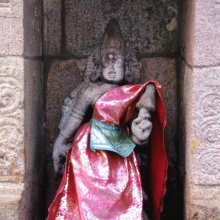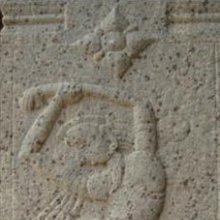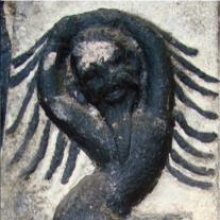Standing posture: 2 definitions
Introduction:
Standing posture means something in Buddhism, Pali, Hinduism, Sanskrit. If you want to know the exact meaning, history, etymology or English translation of this term then check out the descriptions on this page. Add your comment or reference to a book if you want to contribute to this summary article.
Images (photo gallery)
(+8 more images available)
In Hinduism
Natyashastra (theatrics and dramaturgy)
Source: Shodhganga: Elements of Art and Architecture in the Trtiyakhanda of the Visnudharmottarapurana (natya)Standing postures (in Indian Dramas) are classified between (1) Postures for Men and (2) Postures for Women, according to the Viṣṇudharmottarapurāṇa, an ancient Sanskrit text which (being encyclopedic in nature) deals with a variety of cultural topics such as arts, architecture, music, grammar and astronomy.—In the Viṣṇudharmottarapurāṇa standing postures are determined separately for male and female. The difference of physical structure and way of standing position between male and female may be the reason behind this classification.
Six kinds of standing postures are discussed for men viz.—
- vaiṣṇava,
- samapāda,
- vaiśākha,
- maṇḍala,
- āliḍha and
- pratyāliḍha.
Three kinds of standing postures are discussed for women.—
- āyata,
- āvahittha and
- hayakrānta.

Natyashastra (नाट्यशास्त्र, nāṭyaśāstra) refers to both the ancient Indian tradition (shastra) of performing arts, (natya—theatrics, drama, dance, music), as well as the name of a Sanskrit work dealing with these subjects. It also teaches the rules for composing Dramatic plays (nataka), construction and performance of Theater, and Poetic works (kavya).
In Buddhism
General definition (in Buddhism)
Source: A Buddhist Library: In This Very LifeStanding postures should be avoided by beginning Yogis. The standing posture can bring about pain in a short while: tightness and pressure in the legs, which can disrupt the practice.
See also (Relevant definitions)
Partial matches: Posture, Standing.
Full-text (+95): Vaishnava, Vaishakha, Mandala, Pratyalidha, Samapada, Nittirike, Carriage, Hayakranta, Erotic gesture, Ayata, Standing, Vrikshadhirohana, Baithaki, Nimdirike, Sthitasana, Release, Alidhasthana, Sampadasthana, Vaishakhasthana, Mandalasthana.
Relevant text
Search found 32 books and stories containing Standing posture; (plurals include: Standing postures). You can also click to the full overview containing English textual excerpts. Below are direct links for the most relevant articles:
Vishnudharmottara Purana (Art and Architecture) (by Bhagyashree Sarma)
2.3. Standing Postures < [Chapter 3 - Drama and Dance]
2. The Viṣṇudharmottara-purāṇa and the Indian Classical Dances < [Chapter 6 - Modern Relevance of Different Art Forms and Architecture]
Samarangana-sutradhara (Summary) (by D. N. Shukla)
Gati in Theory and Practice (by Dr. Sujatha Mohan)
Description of Gati as in Bharatārṇava < [Chapter 2 - Concept and technique of Gati]
Gati in Yakṣagāna < [Chapter 4 - Practice of Gati]
Gati in Sattriya < [Chapter 4 - Practice of Gati]
Amarakoshodghatana of Kshirasvamin (study) (by A. Yamuna Devi)
Education (10): Knowledge in Archery < [Chapter 4 - Cultural Aspects]
Guhyagarbha Tantra (with Commentary) (by Gyurme Dorje)
Text 6.6 (Commentary) < [Chapter 6 (text and commentary)]
Bhagavati-sutra (Viyaha-pannatti) (by K. C. Lalwani)
Related products






